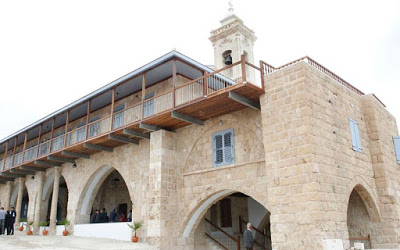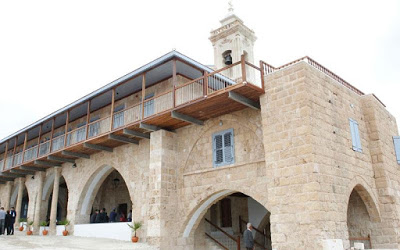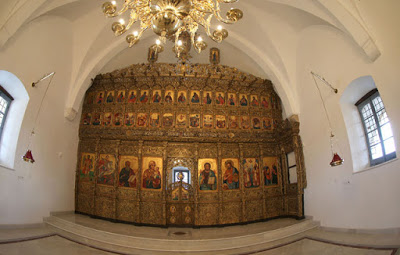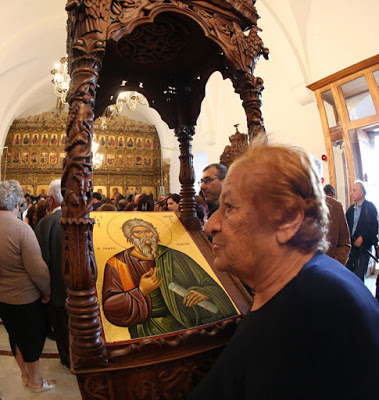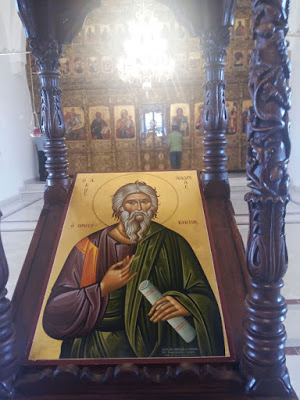Christians and Muslims, Greek Cypriots and Turkish Cypriots worked together and handed over to the Technical Committee for Cultural Heritage on Monday the first phase of the restoration of the Monastery of Apostle Andreas in the occupied Karpasia.
After two years of work, the Monastery, a symbol for the Orthodox Christians in Cyprus, is now able to receive again the faithful and all those who come to it for consolation.
Handing over the project to the Technical Committee during the completion of the Phase A work, Titiana Gennaro, United Nations Development Program - Partnership for the Future, said that the Monastery of the Apostle Andrew is not only an important attraction, but also a symbol of Cyprus. Today, however, it is a symbol of perseverance, unity and peace.
Referring to her friends and associates from the Technical Committee for Cultural Heritage, Takis Hadjidimitriou and Ali Tunzai, she said that together they recognized the value of this Monastery for both communities and with a collective effort secured the necessary support to carry out the maintenance of this common cultural heritage and in 2013 contacted the UNDP seeking its support.
"I thank them for entrusting us with such an important initiative," he said.
He also thanked the Church of Cyprus and EVKAF for the generous funding, and USAID for their contribution, as well as Archbishop Chrysostomos II and Bishop Karpasia Christoforos, who closely monitored the renovation works and accompanied them to several where maintenance work was done.
He also thanked Ibrahim Bender, EVKAF Director, who personally supported the project, he said.
The restoration plans have been prepared by the University of Patras and the work was carried out by a Greek Cypriot-Turkish Cypriot cooperation contractor. Bi-communal teams of electricians, archaeologists and conservators of antiquities collaborated together during the exploratory excavations for the chapel and the renovation of the iconostasis.
"My most special memory from these two years remains the day when Father Zacharias opened the doors of the Monastery for us. "Father Zacharias has all the living memories of this place and is able to tell us about them, something that also contributed to the preservation of the authenticity of the Monastery, based on the preservation and restoration of the original materials and colors," he said.
I would also like to thank my team of UNDP colleagues who accompanied me on this trip, especially Ali Chaglar, Cem Taneri and Emilia Siadu.
The renovation works
Renovation work began in September 2014 and included the complete structural and architectural renovation of the main church, as well as the upgrade of the electrical and mechanical installations. Inside the temple, the womanite expanded. The Holy Table, the iconostasis and the 58 icons were preserved. A new North Stoa was also built based on the original intentions of the monastery architecture.
The total cost of this phase amounted to 2.23 million.
The study for the second phase of the project is expected to be completed, which includes the renovation of the medieval chapel and the fountain, the renovation of all adjacent buildings along with the improvement of the outdoor areas. The start of the second phase is expected in early 2017 and will take a year.
Takis Chatzidimitriou: The glory of the cooperation between Greece and Turkey radiates
We are handing over to Cyprus, to its people and to all of humanity a symbolic monument, said in his speech, the Greek Cypriot member of the Commission, Takis Hatzidimitriou.
"Here, on the edge of Cyprus, in the common homeland of all Cypriots, stands this monastery to remind us of the history of culture, the history of religions as well as great events and great messages that sealed the history of the world," he said.
Greek Cypriots and Turkish Cypriots worked, not without problems, but always with love for the project and did their best to overcome obstacles and difficulties.
"To Apostle Andreas, what now shines and radiates is the glory of the cooperation between Greek Cypriots and Turkish Cypriots. A point of meeting and respect for Christians and Muslims. A living example and message, that can travel to the sea again and say that in Cyprus we can all coexist together with mutual respect and peace. It is still a response to doctrines of intolerance that are shaking Europe and beyond. Today, we here, on the edge of the Mediterranean, live a beautiful day in Cyprus, with the living hope that soon the happy days can become many. To become, like the story of the Apostle Andreas, years and centuries. "For us and our children," he said.
Today, he continued, we are given the privilege and the opportunity to receive renewed and renovated the historic monastery that was in danger of being destroyed. "The Technical Committee together with all its collaborators became, at this critical moment in the history of the island, a bridge of communication in time, in the place but also between people. Christians and Muslims, Greek Cypriots and Turkish Cypriots, we all worked together, together, to save a cultural monument with respect and love. We have given the practical message that culture knows no political or religious boundaries, it is a breath that fills souls, unites and elevates man. "It is a sample of the culture of our people and an example of coexistence in a war-torn region, where the suffering of the people is immense and the destruction of monuments is incalculable."
The Apostle Andreas, in this extreme point of Cyprus, stands like a beacon to illuminate the path of all of us. A lighthouse that leads Cyprus to the future. It transcends hatred and fanaticism, tragedies and crimes and inaugurates a new beginning, a new era of love, peace and coexistence for our small homeland. It establishes the perspective that can not be other than the fellowship of all of us on this earth.
"All Cypriots together, with what characterizes us and with respect for what we are different, we can face the challenges that await us," said Mr. Hatzidimitriou. A new opportunity in history, with the experience we have all gathered, can bring the rebirth of our common homeland.
He named all those who collaborated for the plans of the University of Patras and Diomidis Myriantheas, Archbishop Chrysostomos and Karpasias Christoforos, Dr. Bedef and EFKAF, UNDP-PFF, Titiana Gennaro and Ali Chaglar, contractors Yakup and Hadjipieri and members of the Technical Committee: Ali Tountzai, Glafko Konstantinidi, Figen Janer, Athena Papadopoulou, Ali Yansta Kanali Kari and Mehmet Kanan, with them the speaker as well as the members of the Advisory Board. There are even many others, Greek Cypriots and Turkish Cypriots, workers, engineers, conservators and craftsmen.
Ali Tunjai: This is the true miracle
We are experiencing a real miracle in this Monastery, said the Turkish Cypriot member of the Commission, Ali Tuncay.
This, he said, is the cooperation of the members of the Technical Committee, Muslim Turkish Cypriots and Christian Greek Cypriots, contractors, architects, engineers and workers under the joint funding of EVKAF and the Church of Cyprus for the renovation of this important monument. "So this is the true miracle and this is the tale that must be told to the world," he said.
At this time, while ruthless cultural heritage sites are being destroyed that effectively represent the identity of its people in nearby Syria, we here are an example of how, if handled properly, cultural heritage can help bring different communities and cultures closer together. to each other, he said.
"Cultural heritage has always been a victim of political expediency and as a result, some have always tried to show that the island has belonged to a single national group and culture for thousands of years. "Instead of taking measures to protect cultural heritage, they exploited it for political purposes and for many years one of the two communities was prevented from enjoying the support of the international community in the field of cultural heritage."
"Our cultural heritage and our cultural differences should not cause conflict but should be our wealth that contributes to both communities living peacefully, with prosperity and cooperation," he said.
As a Technical Committee for Cultural Heritage, we have taken a different path, taking big and important steps. "We did not see cultural heritage as a reason to blame each other," he said. "Regardless of origin, we have accepted all the works as our common cultural heritage," he said.
Cyprus is an island where three continents meet, at the "west end of the East" and the "east end of the West". Our island has a history of 10 thousand years, said Mr. Tunchai and all the cultures that passed through here belong to us. One can easily trace them in our culture. "We are the Mycenaeans, and the Phoenicians, and the Romans, and the Byzantines, and the Venetians, and the Ottomans. Both the mosques and the churches are ours. Both the monastery of Apostolos Andreas and the Mosque of Hala Sultan belong to all of us. In short, all the monuments of civilizations that passed through Cyprus constitute our common cultural heritage and our common wealth, ”he pointed out.
The Monastery of Apostolos Andreas is a church where Turkish Cypriots and Greek Cypriots have been worshiping for centuries according to their faith. He called on the clergy not to speak the political language. "They must speak the language of God, peace, compromise, love. "Religious leaders, in particular, should not be biased in front of people who are a creation of God himself," he said.
"The Technical Committee for Cultural Heritage has taught us, among other things, that if we work and produce together, we can be productive. We have shown that working on the basis of respect, equality, mutual trust, we can do projects for the benefit of Turkish Cypriots and Greek Cypriots. "
He wished, like the atmosphere of cooperation that we created, "to find its reflection in other areas for the benefit of the Turkish Cypriots and the Greek Cypriots". He also thanked past and present leaders on both sides for supporting the Commission's work since 2008.
He expressed gratitude to EVKAF (Cyprus Administration of EVKAF) and the Church of Cyprus, which jointly finance the restoration of this important monument, and praised EVKAF's contribution in recent years to the repair and cleaning of dozens of churches in collaboration with the Technical Committee. , as well as his contribution to the restoration of the Monastery of Apostolos Andreas. This reflects the culture of Evkaf, the tolerance and respect for diversity that has prevailed for centuries, he concluded.
Source: KYPE
